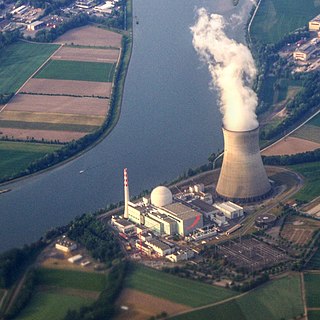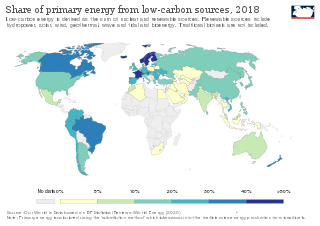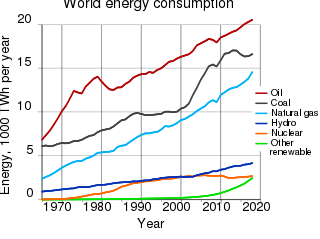Related Research Articles

Nuclear power is the use of nuclear reactions to produce electricity. Nuclear power can be obtained from nuclear fission, nuclear decay and nuclear fusion reactions. Presently, the vast majority of electricity from nuclear power is produced by nuclear fission of uranium and plutonium in nuclear power plants. Nuclear decay processes are used in niche applications such as radioisotope thermoelectric generators in some space probes such as Voyager 2. Generating electricity from fusion power remains the focus of international research.

Energy development is the field of activities focused on obtaining sources of energy from natural resources. These activities include the production of renewable, nuclear, and fossil fuel derived sources of energy, and for the recovery and reuse of energy that would otherwise be wasted. Energy conservation and efficiency measures reduce the demand for energy development, and can have benefits to society with improvements to environmental issues.

Electric power systems consist of generation plants of different energy sources, transmission networks, and distribution lines. Each of these components can have environmental impacts at multiple stages of their development and use including in their construction, during the generation of electricity, and in their decommissioning and disposal. These impacts can be split into operational impacts and construction impacts. All forms of electricity generation have some form of environmental impact, but coal-fired power is the dirtiest. This page is organized by energy source and includes impacts such as water usage, emissions, local pollution, and wildlife displacement.

Uranium mining is the process of extraction of uranium ore from the ground. Over 50 thousand tons of uranium were produced in 2019. Kazakhstan, Canada, and Australia were the top three uranium producers, respectively, and together account for 68% of world production. Other countries producing more than 1,000 tons per year included Namibia, Niger, Russia, Uzbekistan, the United States, and China. Nearly all of the world's mined uranium is used to power nuclear power plants. Historically uranium was also used in applications such as uranium glass or ferrouranium but those applications have declined due to the radioactivity of uranium and are nowadays mostly supplied with a plentiful cheap supply of depleted uranium which is also used in uranium ammunition. In addition to being cheaper, depleted uranium is also less radioactive due to a lower content of short-lived 234
U and 235
U than natural uranium.

A low-carbon economy (LCE) is an economy which absorbs as much greenhouse gas as it emits. Greenhouse gas (GHG) emissions due to human activity are the dominant cause of observed climate change since the mid-20th century. There are many proven approaches for moving to a low-carbon economy, such as encouraging renewable energy transition, energy conservation, electrification of transportation, and carbon capture and storage. An example are zero-carbon cities.
The 2000-watt society concept, introduced in 1998 by the Swiss Federal Institute of Technology in Zurich, aims to reduce the average primary energy use of First World citizens to no more than 2,000 watts by 2050, without compromising their standard of living.
World energy resources are the estimated maximum capacity for energy production given all available resources on Earth. They can be divided by type into fossil fuel, nuclear fuel and renewable resources.

The energy policy of Australia is subject to the regulatory and fiscal influence of all three levels of government in Australia, although only the State and Federal levels determine policy for primary industries such as coal. Federal policies for energy in Australia continue to support the coal mining and natural gas industries through subsidies for fossil fuel use and production. Australia is the 10th most coal-dependent country in the world. Coal and natural gas, along with oil-based products, are currently the primary sources of Australian energy usage and the coal industry produces over 30% of Australia's total greenhouse gas emissions. In 2018 Australia was the 8th highest emitter of greenhouse gases per capita in the world.

Greenhouse gas (GHG) emissions from human activities intensify the greenhouse effect. This contributes to climate change. Carbon dioxide, from burning fossil fuels such as coal, oil, and natural gas, is one of the most important factors in causing climate change. The largest emitters are China followed by the United States. The United States has higher emissions per capita. The main producers fueling the emissions globally are large oil and gas companies. Emissions from human activities have increased atmospheric carbon dioxide by about 50% over pre-industrial levels. The growing levels of emissions have varied, but have been consistent among all greenhouse gases. Emissions in the 2010s averaged 56 billion tons a year, higher than any decade before. Total cumulative emissions from 1870 to 2022 were 703 GtC, of which 484±20 GtC from fossil fuels and industry, and 219±60 GtC from land use change. Land-use change, such as deforestation, caused about 31% of cumulative emissions over 1870–2022, coal 32%, oil 24%, and gas 10%.

Low-carbon electricity or low-carbon power is electricity produced with substantially lower greenhouse gas emissions over the entire lifecycle than power generation using fossil fuels. The energy transition to low-carbon power is one of the most important actions required to limit climate change.

Nuclear weapons testing, uranium mining and export, and nuclear power have often been the subject of public debate in Australia, and the anti-nuclear movement in Australia has a long history. Its origins date back to the 1972–1973 debate over French nuclear testing in the Pacific and the 1976–1977 debate about uranium mining in Australia.
The Australian Uranium Association was an Australian industry trade group which represented companies involved in uranium exploration, mining and export. It operated from September 2006 until 2013, after which its responsibilities were absorbed by the Minerals Council of Australia.

The prospect of nuclear power in Australia has been a topic of public debate since the 1950s. Australia has one nuclear plant in Lucas Heights, Sydney, but it is not used to produce nuclear power. It is used to produce medical radioisotopes.It also produces material or carries out analyses for the mining industry, for forensic purposes and for research. Australia hosts 33% of the world's uranium deposits and is the world's third largest producer of uranium after Kazakhstan and Canada.

The nuclear power debate is a long-running controversy about the risks and benefits of using nuclear reactors to generate electricity for civilian purposes. The debate about nuclear power peaked during the 1970s and 1980s, as more and more reactors were built and came online, and "reached an intensity unprecedented in the history of technology controversies" in some countries. In the 2010s, with growing public awareness about climate change and the critical role that carbon dioxide and methane emissions plays in causing the heating of the Earth's atmosphere, there was a resurgence in the intensity of the nuclear power debate.
Whether nuclear power should be considered a form of renewable energy is an ongoing subject of debate. Statutory definitions of renewable energy usually exclude many present nuclear energy technologies, with the notable exception of the state of Utah. Dictionary-sourced definitions of renewable energy technologies often omit or explicitly exclude mention of nuclear energy sources, with an exception made for the natural nuclear decay heat generated within the Earth.

Energy in Switzerland is transitioning towards sustainability, targeting net zero emissions by 2050 and a 50% reduction in greenhouse gas emissions by 2030.

The environmental impact of the energy industry is significant, as energy and natural resource consumption are closely related. Producing, transporting, or consuming energy all have an environmental impact. Energy has been harnessed by human beings for millennia. Initially it was with the use of fire for light, heat, cooking and for safety, and its use can be traced back at least 1.9 million years. In recent years there has been a trend towards the increased commercialization of various renewable energy sources. Scientific consensus on some of the main human activities that contribute to global warming are considered to be increasing concentrations of greenhouse gases, causing a warming effect, global changes to land surface, such as deforestation, for a warming effect, increasing concentrations of aerosols, mainly for a cooling effect.
Greenhouse gas emissions are one of the environmental impacts of electricity generation. Measurement of life-cycle greenhouse gas emissions involves calculating the global warming potential of energy sources through life-cycle assessment. These are usually sources of only electrical energy but sometimes sources of heat are evaluated. The findings are presented in units of global warming potential per unit of electrical energy generated by that source. The scale uses the global warming potential unit, the carbon dioxide equivalent, and the unit of electrical energy, the kilowatt hour (kWh). The goal of such assessments is to cover the full life of the source, from material and fuel mining through construction to operation and waste management.
The Single Electricity Market encompassing the entire island of Ireland does not, and has never, produced any electricity from nuclear power stations. The production of electricity for the Irish national grid (Eirgrid), by nuclear fission, is prohibited in the Republic of Ireland by the Electricity Regulation Act, 1999 . The enforcement of this law is only possible within the borders of Ireland, and it does not prohibit consumption. Since 2001 in Northern Ireland and 2012 in the Republic, the grid has become increasingly interconnected with the neighbouring electric grid of Britain, and therefore Ireland is now partly powered by overseas nuclear fission stations.
Thorium Energy Alliance (TEA) is a non-governmental, non-profit 501(c)3, educational organization based in the United States, which seeks to promote energy security of the world through the use of thorium as a fuel source. The potential for the use of thorium was studied extensively during the 1950s and 60s, and now worldwide interest is being revived due to limitations and issues concerning safety, economics, use and issues in the availability of other energy sources. TEA advocates thorium based nuclear power in existing reactors and primarily in next generation reactors. TEA promotes many initiatives to educate scientists, engineers, government officials, policymakers and the general public.
References
- ↑ Charles Barton, David Fleming and Jan Willem Storm van Leeuwen
- ↑ Jan Willem Storm van Leeuwen (1985). "Nuclear uncertainties: Energy loans for fission power". Energy Policy: 253–266. doi:10.1016/0301-4215(85)90158-2.
- 1 2 Jan Willem Storm van Leeuwen; Philip Smith (30 July 2005). "Nuclear Energy: the Energy Balance" (PDF). Retrieved 2008-01-18.
- ↑ http://gabe.web.psi.ch/pdfs/Critical%20note%20GHG%20PSI.pdf Dones, Roberto, 2007. Critical note on the estimation by storm van Leeuwen J.W. and Smith P. of the energy uses and corresponding CO2 emissions from the complete nuclear energy chain. Paul Scherrer Institute Policy Report, April |archive-url=https://web.archive.org/web/20111011225201/http://gabe.web.psi.ch/pdfs/Critical%20note%20GHG%20PSI.pdf |archive-date=10 Oct 2011 |url-status=dead
- ↑ Martin Sevior (2006-06-02). "Response from Martin Sevior to rebuttal 2 from Jan Willem Storm van Leeuwen" . Retrieved 2009-12-06.
- ↑ "Energy Analysis of Power Systems". World Nuclear Association. March 2006. Archived from the original on 2013-02-15. Retrieved 2008-04-30.
- ↑ David Fleming (April 2006). "Why Nuclear Power Cannot be a Major Energy Source" . Retrieved 2009-12-06.
- ↑ Frank Barnaby, Keith Barnham, James Kemp, Paul Rogers, Jan Willem Storm van Leeuwen (March 2007). Secure Energy? Civil Nuclear Power, Security and Global Warming. Oxford Research Group (ORG), UK. p. 56. ISBN 978-0-9552846-1-8 . Retrieved 2008-04-26.
{{cite book}}: CS1 maint: multiple names: authors list (link) - ↑ Moira Herbst (2007-03-26). "New Debate Over Nuclear Option". Business Week. Archived from the original on 2008-03-02. Retrieved 2008-04-26.
- ↑ Lenzen, M. (2008). "Life cycle energy and greenhouse gas emissions of nuclear energy: A review. Energy Conversion and Management" (PDF). University of Sydney. p. 69. Archived from the original (PDF) on 2013-09-03. Retrieved 2013-11-08.
Frank Barnaby, James Kemp and others
- ↑ "Author Jan Willem Storm van Leeuwen". OpenDemocracy. Archived from the original on 2008-07-05. Retrieved 2008-04-26.